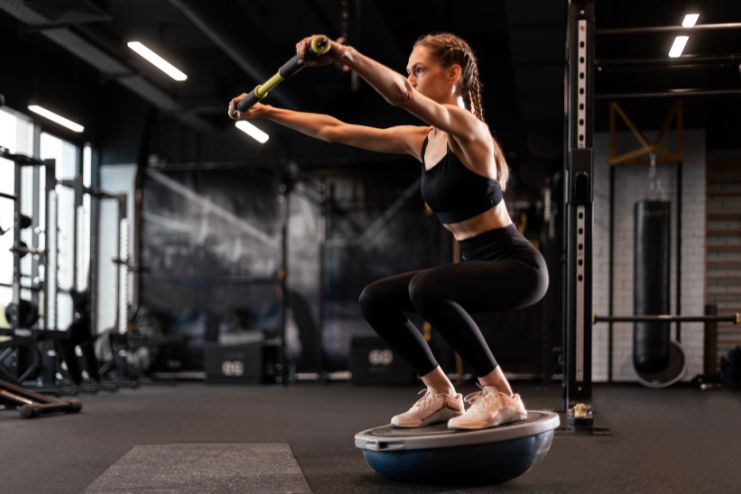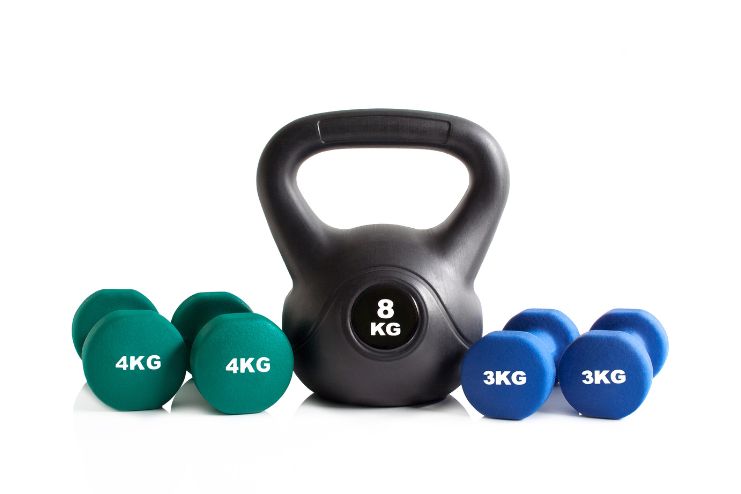Affiliate Disclaimer
Some links in this article are affiliate links. We may earn a small commission if you make a purchase through these links, at no extra cost to you. We only recommend products we find useful to our readersLoaded mobility involves performing controlled movements through a full range of motion with added resistance, which helps build both strength and flexibility. When most people think of mobility, they often picture static stretching or yoga poses.
But what if you could enhance both your flexibility and strength by adding weight to your mobility routine? That’s where loaded mobility comes in—a powerful blend of strength and flexibility training that optimizes movement and reduces the risk of injury.
This approach is ideal for athletes, weightlifters, or anyone looking to improve their mobility and performance. The beauty of loaded mobility is that it targets areas that static stretching often misses, allowing you to move more efficiently and with better control.
In this article, we’re diving deep into the world of loaded mobility and why it’s becoming a game-changer for those serious about improving their movement. We’ll start by explaining what loaded mobility is and the key benefits that set it apart from traditional stretching.
Then, we’ll walk you through the best exercises to incorporate into your routine and give you practical tips on how to fit loaded mobility into your training. Finally, we’ll cover common mistakes to avoid so you can maximize your results and move with confidence.
Ready to take your mobility to the next level? Let’s get started!
What Is Loaded Mobility?

Loaded mobility involves using external resistance—such as dumbbells, kettlebells, or resistance bands—to improve both flexibility and strength. Unlike traditional stretching, which focuses solely on passive movement, loaded mobility targets muscles at their end range of motion, helping you gain greater control and reducing the risk of injury.
So, how is it different from static stretching? Static stretches may increase flexibility, but they don’t develop the strength needed to control movement in those extended positions. Loaded mobility, on the other hand, builds both flexibility and strength, ensuring better movement control.
The science behind loaded mobility is simple: it trains your nervous system to support movement at extreme ranges, strengthens connective tissues, and enhances joint stability. By combining deep stretches with muscle activation under resistance, you increase your ability to move safely through a larger range of motion, making your gains more durable and significantly lowering the risk of injury.
Key Benefits of Loaded Mobility

Loaded mobility offers a unique approach to improving both strength and flexibility, making it a powerful addition to any training routine. By adding weight to mobility exercises, you can unlock a host of benefits that go beyond just being more flexible. Let’s dive into why loaded mobility is worth incorporating into your routine:
- Improves Active Range of Motion: Loaded mobility allows you to move deeper into positions while maintaining strength and control, helping you develop a more functional range of motion.
- Enhances Joint Stability: By strengthening connective tissues, loaded mobility helps prevent hypermobility and instability issues, ensuring your joints stay strong and secure.
- Boosts Functional Strength: Since these exercises mimic real-life and athletic movements, they make everyday tasks and workouts easier, improving coordination and control in the process.
- Reduces Injury Risk: By addressing joint imbalances and stiffness, loaded mobility helps prevent common injuries like strains and sprains, while also reducing long-term damage.
- Enhances Recovery: Increased blood flow from loaded mobility exercises helps reduce soreness and aids in muscle recovery between workouts, helping you stay consistent in your training.
- Improved Athletic Performance: By combining flexibility and strength, loaded mobility enhances power, speed, and agility, making it perfect for athletes looking to boost performance.
- Supports Better Posture and Core Strength: These exercises also improve posture and core strength, essential for maintaining a healthy spine and reducing the risk of injury.
- Increases Connective Tissue Resilience: Loaded mobility strengthens the connective tissues, improving their resilience to stress and making them less prone to injury.
- Improves Movement Efficiency: With better coordination, stability, and control, you’ll be able to move more efficiently and handle multi-directional movements with greater ease.
Incorporating loaded mobility into your routine means building not just flexibility, but strength, stability, and control—all of which contribute to improved overall performance.
Why Loaded Mobility Works

Loaded mobility training is highly effective because it blends strength and flexibility, ensuring that you’re not just stretching but actively stabilizing and strengthening your joints in extended ranges of motion. This combination allows you to maintain control in deeper positions, preventing injury and improving your overall movement quality.
Unlike traditional static stretching, which only focuses on increasing flexibility, loaded mobility strengthens muscles and connective tissues, helping you move more efficiently. It also trains your nervous system to support movements in extreme ranges, enhancing both joint stability and resilience. By improving both strength and flexibility, loaded mobility reduces stiffness, prevents hypermobility, and addresses joint imbalances.
Best Loaded Mobility Exercises

If you’re ready to take your mobility and strength to the next level, incorporating loaded mobility exercises is a game-changer. These exercises involve adding resistance—such as dumbbells, kettlebells, or bands—into your mobility routine, allowing you to improve flexibility, strength, and control simultaneously. Here’s a breakdown of some of the most effective loaded mobility exercises for different parts of the body.
For Hips & Lower Body:
- Cossack Squats with Dumbbell: A lateral movement that strengthens the hips and improves flexibility, allowing for better lateral control. This exercise helps you move deeper into positions while maintaining strength.
- Jefferson Curls: This exercise stretches the hamstrings and enhances spinal mobility by performing a loaded forward fold. It promotes deep stretching with control, improving the flexibility of your spine and posterior chain.
- Kettlebell Hip Flexor Stretch: Not only does this stretch improve flexibility, but it also builds strength in hip extension, ensuring better hip mobility and stability, especially for dynamic movements.
For Shoulders & Upper Body:
- Kettlebell Arm Bars: A fantastic exercise for developing scapular stability and shoulder mobility. It strengthens and stabilizes the shoulders while moving through different ranges of motion.
- Turkish Get-Ups: This full-body movement enhances strength, coordination, and mobility. By moving through different planes, it improves functional strength and overall control of your body.
- Weighted Shoulder Dislocates: A controlled, weighted stretch that gradually improves shoulder flexibility and mobility. This exercise targets tightness and builds strength around the shoulder joint, ensuring a better range of motion and stability.
For Spine & Full-Body Mobility:
- Controlled Articular Rotations (CARs) with Resistance: These rotational exercises improve joint control and mobility throughout the body. Adding resistance enhances the effectiveness, helping to strengthen joints while improving flexibility in a controlled manner.
- Loaded Deep Squat Holds: A powerful exercise for improving ankle, knee, and hip flexibility. Holding a deep squat position with weight strengthens and stretches the entire lower body.
- Goblet Squats with Pause: By holding a dumbbell or kettlebell in front of your chest, this deep squat variation enhances hip mobility. Pausing at the bottom of the movement builds control and stability in the deepest range of motion.
READ MORE: Daily Stretching Exercises for Flexibility and Mobility
Important Considerations for Loaded Mobility Exercises

Before diving into loaded mobility exercises, there are a few key things to keep in mind to ensure you’re getting the most out of your movements while minimizing the risk of injury. Mobility training is all about moving better and feeling stronger, but it needs to be approached with care and consistency.
- Warm-up: Always warm up properly before starting any loaded mobility exercises. A dynamic warm-up prepares your muscles and joints for an increased range of motion and resistance, reducing the risk of injury.
- Proper Form: Maintaining good form is crucial. Focus on technique over weight. Proper alignment and controlled movement are the foundation of effective and safe mobility training, so don’t rush through exercises.
- Listen to Your Body: If you feel any pain or discomfort during an exercise, pay attention. It’s important to differentiate between muscle fatigue and actual pain. Adjust the exercise or reduce the weight if needed.
- Progress Gradually: Start light, especially if you’re new to loaded mobility work. Over time, as you build strength and improve your mobility, gradually increase the weight. Pushing too hard too soon can lead to setbacks.
- Consistency: Improvement takes time, so stick with it. Regular practice is key to enhancing mobility and flexibility. Incorporate these exercises into your routine consistently for the best results.
How to Incorporate Loaded Mobility into Your Routine

Loaded mobility exercises can easily become a versatile part of your fitness routine, offering benefits like improved flexibility, joint health, and strength. Whether you’re prepping for a workout or recovering after a tough session, here’s how to seamlessly add loaded mobility to your daily or weekly regimen.
- As a Warm-Up: Start your workout with light weights and controlled movements to prepare your joints and muscles. Loaded mobility as a warm-up helps activate key muscle groups while increasing blood flow, setting you up for a more effective and safer workout.
- As Active Recovery: On rest days, incorporate loaded mobility exercises to maintain joint health and reduce stiffness. These exercises support flexibility, aid muscle recovery, and help you feel more limber and energized.
- As a Strength Routine: Pair loaded mobility drills with your regular strength training to create a balanced workout program. These exercises target deeper movement patterns, helping you build functional strength while maintaining or improving your mobility.
READ MORE: Incorporating Functional Training for Everyday Strength and Mobility
Tips for Incorporating Loaded Mobility
Incorporating loaded mobility exercises into your routine doesn’t have to be complicated. With a few mindful adjustments, you can gradually make it a natural part of your day. Here are some simple yet effective tips to get started and maximize the benefits:
- Start Slow: If you’re new to loaded mobility exercises, begin with lighter weights and gradually increase the load as you gain confidence and control.
- Focus on Form: Prioritize good form over heavier weights. Ensuring proper technique will not only prevent injuries but also maximize the effectiveness of each exercise.
- Listen to Your Body: Pay attention to how your body feels during each movement. If something doesn’t feel right, adjust your routine or weight accordingly. Mobility is about control, not just pushing through discomfort.
- Make it a Habit: Consistency is key. Integrate loaded mobility exercises regularly into your routine for the best results. Whether you include them in every workout or dedicate a few sessions per week, consistency leads to long-term improvements.
- Incorporate into Daily Activities: Make mobility exercises part of your everyday life by stacking them with other activities. Stretch while watching TV, or do some light mobility work while brushing your teeth. Small, regular movements can have a big impact over time.
Common Mistakes to Avoid

When integrating loaded mobility exercises into your routine, it’s essential to do them right to fully benefit and avoid potential setbacks. While these exercises can significantly improve your strength and flexibility, small errors can reduce their effectiveness or even lead to injury. To help you stay on track, here are some common mistakes to watch out for and avoid:
- Skipping Warm-ups: A dynamic warm-up is essential to prepare your muscles and joints for loaded mobility work. It increases blood flow and reduces the risk of injury.
- Using Too Much Weight Too Soon: Start with light weights, prioritizing control and proper form, as this is far more effective than rushing into heavier loads.
- Moving Too Fast: Slow, controlled movements are key to mobility exercises. Rushing through can compromise your form and limit the benefits.
- Ignoring Stability & Core Engagement: Always engage your core during movements. This keeps your body stable and prevents other muscles from compensating improperly.
- Neglecting Form: Maintaining proper form ensures you’re working the right muscles and preventing injuries. Never sacrifice form for weight or speed.
- Ignoring Pain Signals: Pain is a warning sign—never push through sharp or intense discomfort. Stop immediately and reassess your form or the load you’re using.
- Skipping Post-Workout Stretching: Stretching after your workout helps relax muscles and improve recovery. Neglecting this can lead to stiffness and reduced flexibility.
Final Thoughts
Loaded mobility exercises provide a balanced way to enhance both strength and flexibility, promoting a greater range of motion, stability, and control. Incorporating movements like goblet squats, Cossack squats, kettlebell arm bars, and Turkish get-ups into your routine can enhance your hip, shoulder, and spine mobility while also building strength in these key areas. The real benefits, however, come with mindful execution—always warm up before beginning, start with lighter weights, and prioritize controlled movements to maintain proper form.
Equally important is listening to your body and progressing gradually to avoid injury. Loaded mobility exercises are versatile, serving as warm-ups, active recovery, or part of your strength routine, so they can be adapted to meet your specific goals. Consistency is crucial for long-term improvements, and habit-stacking can help you integrate these exercises into your daily routine. By focusing on proper form, stability, and a steady progression, you’ll develop stronger, more mobile joints and muscles for overall improved performance.
Mobility is unlocked through strength.
References
- How Flexibility and Mobility Help You Stay Strong and Healthy for Life
- Peloton’s Ultimate Guide to Mobility Training
- The Surprising Benefits of Performing Daily Mobility Exercises
- How The Usage Of Loaded Mobility Can Help To Increase Your Flexibility And Strength
- 15 Best Mobility Exercises to Boost All Kinds of Workouts
- Loaded Mobility: A Short Cut to Ease of Movement
- Your 10-step guide to moving better
- Loaded Mobility for Improving and Maintaining Flexibility
- 7 Stretching Mistakes and How to Avoid Them
- CrossFit Mobility 101: Three Common Mobility Mistakes
In this Article

















